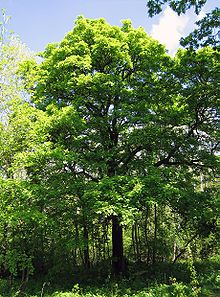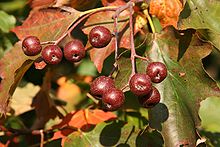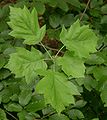- Sorbus torminalis
-
Sorbus torminalis 
A mature tree in spring Scientific classification Kingdom: Plantae (unranked): Angiosperms (unranked): Eudicots (unranked): Rosids Order: Rosales Family: Rosaceae Genus: Sorbus Subgenus: Torminaria Species: S. torminalis Binomial name Sorbus torminalis
(L.) CrantzSynonyms Torminalis clusii (Roemer) K.R.Robertson & J.B.Phipps
Sorbus torminalis (syn. Torminalis clusii, Wild Service Tree), sometimes known as the Chequer(s) Tree or Checker(s) Tree, is a species of Sorbus native to Europe from England and Wales east to Denmark and Poland, south to northwest Africa, and southeast to southwest Asia from Asia Minor to the Caucasus and Alborz mountains.[1][2]
It is a medium-sized deciduous tree growing to 15–25 m tall, with a trunk up to 1.3 m diameter. The bark is smooth and greyish, but flaky, peeling away in squarish plates to reveal darker brown layers. The leaves are 6–14 cm long and broad with a 2.5–5 cm petiole, dark green on both sides, with five to nine acute lobes; the basal pair of lobes are spreading, the rest more forward-pointing and decreasing in size to the leaf apex, and with finely toothed margins; the undersides have small hairs when young, but both sides are smooth and shiny when older; the autumn colour is yellow to red-brown. The flowers are 10–15 mm diameter, with five white petals and 20 creamy-white stamens; they are produced in corymbs 5–12 cm diameter in late spring to early summer, and are hermaphrodite and insect pollinated. The fruit is a globose to ovoid pome 10–15 mm diameter, greenish to russet or brown, patterned with small pale lenticel spots when mature in mid to late autumn.[1][3][4][5]
- Sorbus torminalis var. torminalis. Europe, northwest Africa.
- Sorbus torminalis var. caucasica. Caucasus and Alborz Mountains. Leaves less deeply lobed than in var. torminalis.
Contents
Ecology
It is relatively rare and in Britain is now usually confined to pockets of ancient woodland, although it can also be found growing in hedgerows. It can often be found associated with oak and ash woods, preferring clay and lime based soils. In Britain, summer temperatures are often too low for the seeds to ripen, so its principal method of propagation is by suckers.[1]
A number of often very localised stable apomictic species of ultimately hybrid origin between Sorbus torminalis and various species in the subgenus Aria (whitebeams) occur in Europe, including Sorbus latifolia (Service Tree of Fontainebleau), and Sorbus bristoliensis (Bristol Whitebeam).[1]
Uses and etymology
The fruit, sometimes called "chequers", are edible and taste similar to dates, although they are now rarely collected for food. They are usually too astringent to eat until they are over-ripe and bletted. They were traditionally known as a herbal remedy for colic; the tree's Latin name, torminalis means 'good for colic'. Before the introduction of hops, the fruit were used to flavour beer, which may be related to the ancient symbol of a pub being the chequer-board (although it has also been suggested that the pub name itself was originally brought by the Romans [6]). Alternatively, the name "chequers" may have been derived from the spotted pattern of the fruit,[7] though some suggest from the pattern of the bark on old trees.[5]
Gallery
Further reading
- Wedig Kausch-Blecken von Schmeling: Die Elsbeere. Bovenden 1994, ISBN 3-88452-925-0
References
- ^ a b c d e Rushforth, K. (1999). Trees of Britain and Europe. Collins ISBN 0-00-220013-9.
- ^ Euro+Med Plantbase Project: Sorbus torminalis
- ^ Mitchell, A. F. (1974). A Field Guide to the Trees of Britain and Northern Europe. Collins ISBN 0-00-212035-6
- ^ Blamey, M. & Grey-Wilson, C. (1989). Flora of Britain and Northern Europe. ISBN 0-340-40170-2
- ^ a b Cambridge University: plantsci.cam.ac.uk Sorbus torminalis
- ^ The Cheqiers In at tamwprth-heritahe piubs.co.uk
- ^ Oxford English Dictionary
Categories:- Sorbus
- Flora of Lebanon
Wikimedia Foundation. 2010.






